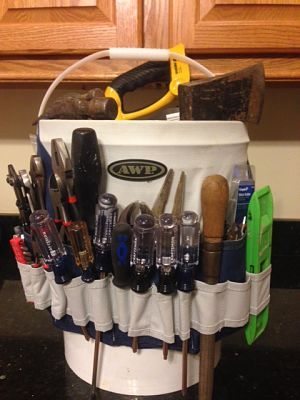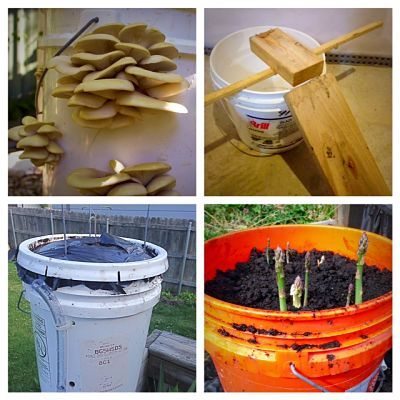From Marjory Wildcraft’s GrowYourOwnGroceries.org
Life on the homestead requires a lot of creativity and frugality. The “5 R’s” seem to be constantly in play: Reuse, Reduce, Recycle, Re-purpose, and Repair. Nothing ever goes to waste on the homestead! Today’s waste simply becomes tomorrow’s resources.
When buying something new is necessary, I usually try and make sure the item fits into one of the following criterion: First, does the item have more than one alternative use or purpose? Second, does the item take up minimal space? Third, is the item inexpensive?
This wonder tool is no other than the five gallon plastic bucket! Not only do these nest neatly into a tidy stack, they also have a seemingly unlimited amount of uses. Whether you are into Homesteading, Preparedness, or Permaculture, five gallon buckets are essential tools of the trade!
Oh, I almost forgot about the third criterion, Price! If purchased from a hardware store, you can expect to pay anywhere from $3 – $5 dollars per bucket. But you can acquire them for FREE from your grocery store’s bakery department. All you have to do is ask nicely for the buckets that their icing came in. Other sources include pickle buckets from hamburger joints, soap buckets from car washes, and lard buckets from Mexican Restaurants. Be prepared to clean them!
So what exactly can you do with a five gallon bucket once you procure them? I thought you would never ask! Below I will showcase some general ideas that I use quite frequently. If you’re keen on any given idea, more detailed tutorials can be found all over the “interweb,” as my dad calls it.
First and foremost, five gallon buckets make outstanding container gardens when you drill drainage holes in the bottom of the buckets. While permaculturists might frown on the idea of container gardens, they are quite useful if you want to keep invasive (opportunistic) plants such as mint from taking over your garden. Additionally, in a grid-down situation you can easily secure your food indoors overnight to protect from potential looters. That brings a whole new meaning to “food security!”
Another clever use of a bucket is by growing edible and medicinal mushrooms in them. Just drill staggering holes in the sides of the bucket, fill the bucket with free coffee grounds from the local corner coffee shop, and inoculate with the spawn of your favorite mushroom.
Five gallon buckets also make for a great tool bag. Hardware stores sell organizers specifically made for buckets that have all kinds of compartments. The outside sleeve compartments of the bucket are ideal for your smaller tools such as screwdrivers, wrenches, and pliers. On the inside of the bucket you can store your heavy duty tools like your hammers, axes, and saws.
You can even make wine with a five gallon bucket. Simply pour in some apple cider (sans preservatives), sugar, and yeast. Drill a hole into the lid, insert a rubber grommet, and then insert an airlock bubbler (available for $1 at most homebrew stores). The Big Bird/Cookie Monster style explanation is that the yeasties eat the sugar and essentially poop out carbon dioxide and alcohol. The airlock bubbler allows the carbon dioxide to escape, but prevents oxygen or other contaminants from entering your wine. There are a few more specific steps and ingredients that go into producing quality wine, but this is the basics of how wine is made! People drink alcohol in both good times and bad. Wine making can prove to be a very valuable and profitable skill in a grid down scenario.
One of my favorite uses of a five gallon bucket is for a vermicompost system (a worm bin). I have not seen anyone out there use my design, but I feel that it is the best design out there that uses a single five gallon bucket. If there is enough interest, I will make a YouTube video and write up with detailed instructions. Red wiggler worms are veracious eaters. I feed them my shredded junk mail and food scraps. In return, they give me “black gold.” If mushroom compost is the Cadillac of compost, Worm Castings are the Rolls Royce of compost!
In addition to vermicompost, compost tea happens to be the secret of many master gardeners. And with a five gallon bucket, you can brew your own compost tea right at home. All you need is an aeration air pump, some worm castings (compost), non-chlorinated water, and a few other ingredients. After two days of brewing it is ready to spray on your crops using a pump sprayer. Your plants will grow twice as big, twice as fast!
Have a mouse problem, but don’t have the heart to set out a traditional mouse trap? Well you can make a catch & release mouse trap out of a bucket and a few pieces of wood and peanut butter for bait. The contraption reminds me of the board game “mousetrap” I used to play as a child!
Lastly, you can make a heavy duty water filter from two 5 gallon buckets stacked on top of each other. The top bucket has a ceramic water filter that filters out the dirty water dumped into it. The bottom bucket has a water spigot that allows you to extract the newly filtered water.
I hope you enjoyed some of the examples I have provided of why five gallon buckets are the absolute best and most versatile tool for homesteading, preparedness, and permaculture. Five gallon buckets not only serve as a container to grow your food in, they can be used in creating the fertilizer that enriches your food. To top it off you can use buckets to collect and ultimately store your bountiful harvests!








